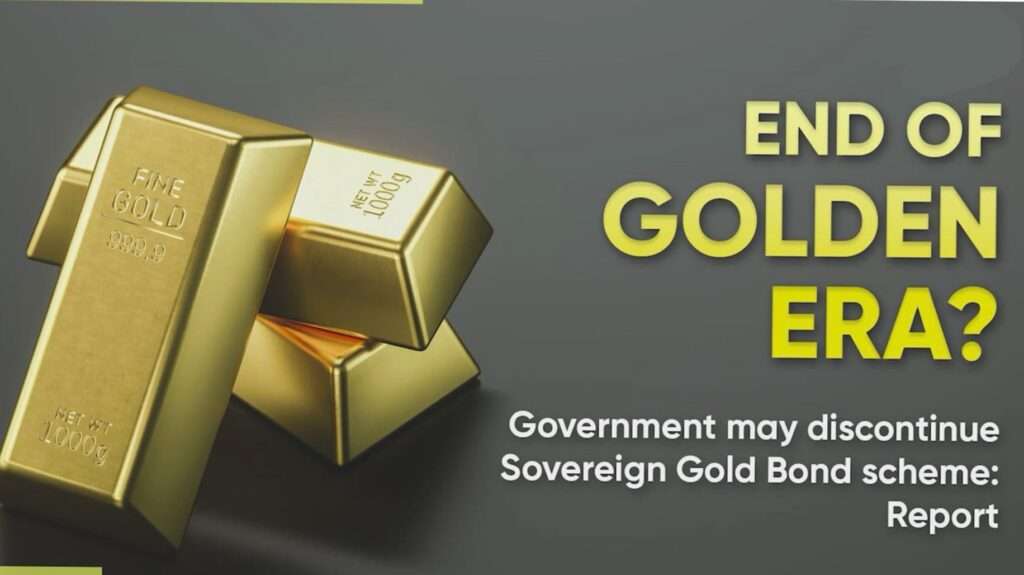Is India Ready to Stop Sovereign Gold Bonds? What This Could Mean for Investors?
The Indian government's plan to stop issuing Sovereign Gold Bonds (SGBs) has caught the attention of investors and financial experts. It's believed that the rising costs and difficulties of managing the program are behind this decision. This has led to questions about what this means for gold investments in India and how it might affect investors and the economy.

The recent announcement that the Indian government may cease issuing Sovereign Gold Bonds (SGBs) has sparked significant interest and debate among investors and financial analysts alike. If various reports are to be believed, this high cost and rise in complexity behind the program are some of the factors prompting such a step really needed to put a question mark on the future of gold investments in India, its consequences for investors, and the economy in general.
Sovereign Gold Bonds Background
The Indian government, in the year 2015, introduced Sovereign Gold Bonds, a calculated move to cut the country’s dependence on physical gold imports in an organized manner. The import of physical gold has played a significant role in causing the Indian current account deficit, which means that the combined value of goods, services, and transfers into a country is more than the value of the same. To stabilize the economy a bit and put less pressure on foreign exchange reserves, the government has, through SGBs, targeted the price of domestic savings into financial instruments inflow rather than into physical gold.
The SGB has been well-received by investors, as the RBI has issued 67 tranches to date and raised around ₹72,274 crore. These bonds are denominated in grams of gold, which allows the investors to gain from the appreciation of gold prices sans the attendant costs of storage and security. Apart from these, SGBs also provide an annual interest rate of 2.5% that gets payable semiannually, hence most ideally lucrative for investment purposes.
The background to the high success of SGBs can be explained below. First and foremost, it provided the investors with exposure to a safe asset like gold without the physical hassles and problems of storage and security of the metal. The semi-annual interest payments provided an additional income stream, which was particularly attractive in times of economic uncertainty. Finally, it was the sovereign backing that added an element of safety and confidence, thereby making SGBs an ideal instrument for conservative investors.

Since the day they were introduced, SGBs have been attracting a varied investor base of retail, institutional, and high-net-worth investors. The high subscriptions of SGBs, therefore, are not surprising.
Why Has the Government Decided to Do So?
Among others, the major underlying indicators behind such a possible government decision enormous financial burden and the complexities involve with running the program. With the growth in the SGB scheme, it has brought with it problems in management.
The surging price of gold has upped the financial burden of the government by a few notches. According to the current budget documents, the government has a pending payment of about ₹85,000 crore to the investors compared to less than ₹10,000 crore as of March 2020. This increase in liabilities by nine times poses severe stress on the government’s finances in terms of substantial payout liabilities to the bondholders at the time of maturity.
This financial pressure is also worse off by the fact that the government is under an obligation to redeem the bonds once they mature at the prices of gold in the market. With the increase in the price of gold, these liabilities for the government are bound to rise and worsen the financial crunch.
Complexity of Management
Running the SGB scheme has been found to be resource-intensive and complex for the government. Furthermore, such redemptions and interest payments are things that require proper records and, at present, include administrative complexities, which, over time, may not prove sustainable. Administratively, therefore, as the program assumes larger scales, the government will have to commit more resources to ensure its administration—all this at the expense of other important economic priorities.
The administrative issues and the pitfalls of the scheme are not only for the government to tackle. It is also imperative for an investor to understand the complicated terms and conditions of SGBs, such as tax responsibility, mechanism of redemption, and market dynamics in the secondary markets.
On secondary markets, demand for SGBs soared as investors were willing to pay out as much as 8% above the government’s reference price on the instruments as of August 14, 2024. This means there is speculation interest in this instrument that could be at variance with the government’s long-term financial strategy. The government may be getting worried that this secondary market is becoming too volatile, which may bring unintended consequences, such as a rise in risk exposure for investors.
It may also develop further price distortions that could lead to significant deviation of the market price from the intrinsic prices of SGBs. Most importantly, this may bring challenges for the government in the earnest effort to maintain the credibility and stability of the SGB program.
Economic Strategy
Through the reduction in the issuance of the SGB, the government might be stepping back a bit to reconsider its economic strategy. Its goal could lie in a search for other alternatives for much safer, sustainable financial instruments that would not impose such heavy liabilities. The government may also be seeking diversification of investments to look at alternative mechanisms for channeling domestic savings into productive economic activities that support long-run development and growth.
It could also be one step further for more significant economic goals of the government that require bringing down the current account deficit, inflation control, and domestic investment promotion in other sectors. The reallocation of resources from the SGBs might also lend, at least partially, some balance toward a more sustainable economic growth model for the government.
Implications for the Investors

This possible cessation in issuance would, therefore, affect new investors and those who currently hold the bonds. Existing bondholders would keep benefiting from such bonds until they mature. Still, the cessation in their issuance would act as a tourniquet on future opportunities to invest in this class of assets.
Investors who have already invested in SGBs will, of course, continue to get the benefits of the bonds until maturity, subject to their holding them till the end of the respective investment terms. With new issuances coming to an end, hence, the future opportunities of investing in this asset class will be lost. This can depress the overall returns for customers who were waiting to re-deploy their proceeds in new SGBs at maturity.
Furthermore, ceasing to issue new SGBs can diminish the liquidity of the secondary market, given that fewer new bonds would be available to go around. This may increase the difference in bid-ask spreads, which could stop investors from either buying or selling SGBs at reasonable prices.
Such instruments will be more market-active when new SGBs are no longer issued. Investors will instead tend to trade their bonds more frequently, implying greater price volatility. It could be an opportunity for investors ready to take higher risks in pursuit of potential gains, but it also could expose them to more significant market uncertainties.
The high volume of transactions in the secondary market may also lead to speculative trading, where investors buy and sell SGBs based on short-term price movements rather than long-term investment goals. It may further increase the market volatility and the risk of sizable price swings.
In such a scenario, investors might have to fall on other kinds of gold investments like gold ETF or physical gold, each having its own sets of positive and negative points. This could end in a number of investment strategies getting diversified among people who otherwise only relied upon SGBs.
Gold ETFs offer a more convenient way to trade on stock exchanges and expose oneself to the price of gold without bothering with storage. However, it comes with a management fee and may not give the same returns that an SGB offers to investors. On the other hand, physical gold may offer absolute ownership but comes with many storage and security-related problems. They will need to closely assess the risks and benefits of both options in order to decide the best investment strategy that will be in their best interest and help them cope with the risk levels.
Should the Government Stop SGB Issuance?
This decision has its share of critics, with a view that SGBs have done an excellent service by allowing people to invest in gold without the drawbacks of actual physical gold. A unique attraction for those seeking a haven investment in times of economic uncertainty, gold is often considered a hedge against inflation and market volatility.
On arguments to continue with SGBs, being the proponents to continue with this SGB, there are certain critical functions it serves:
• Investor Protection: Investors are able to get exposure to gold in a more secure and regulated way under the scheme rather than through physical gold, whether by way of theft or damage risks.
• Economic Stability: Helps channel savings towards SGBs, thus aiding in the reduction of the current account deficit and ensuring stability in the economy.
• Financial Inclusion: Through SGBs, retail investors get an easy route for investment, particularly those classes of investors who are unable to invest due to a lack of investing capacity or know-how in other instruments.
• Inflation Hedge: Gold is seen as a hedge against inflation, and SGB enables investors to reap these benefits without getting entangled in the ownership of physical gold.
The mounting liabilities associated with the SGBs clearly have an impact on fiscal stability in an unstable economic environment. The government has to weigh the benefits of continuation against the liabilities created and the opportunity costs of resources going out in favor of other financial priorities.
Besides, the administrative capacity for such growing complexities of the SGB program may become a constraint on the part of the government, especially if it continues to expand. Added to the administrative problems is the monetary cost of carrying out the SGB program, which makes it even harder for the government to argue for continuing the SGB scheme.
Impact of Discontinuing SGB Issuance

Suppose the government goes ahead and does not release any more SGBs in the near future. In that case, it will have specific short- and long-term effects on investors, financial markets, and the broader economy, compelling the policymakers to consider the same.
The stoppage of SGB issuances could dent investors’ sentiment toward government-backed investment instruments and may cause a loss of confidence in new programs in the future. This could present a problem for the government when rolling out any new financial products or initiatives dependent on investor participation.
This will also lead to an automatic change in the cash flow pattern in different avenues, including SGBs, as changes in this arena are subject to investor behavior patterns characterized by increased caution and conservatism in making investment decisions, likely to be adopted if and when such a possibility is realized. This may also result in the lowering of aggregate investment activity levels and reduced participation in financial markets.
Discontinuation of the SGBs may end up taking the demand to other gold-linked investment products, which might be gold ETFs or physical gold. This shall then drive up the prices of these alternatives as investors scramble to retain exposure to gold in its absence.
It raises the demand for other instruments that serve gold investment. Simultaneously, it would open up newer avenues for financial institutions and investment companies to design and introduce new products to serve a gold investor’s needs. However, these products might not have that secure touch and might not have the backing of the government that the SGBs provide, thus putting the investors at risk.
This may cause the government to reconsider its strategy for managing the current account deficit, which could change if the patterns of gold imports change. In the absence of the SGB scheme to take away the demand for domestic gold, the imports of physical gold could go up, which, on the one hand, would work to strain the current account and put pressure on the country’s foreign exchange reserves.
The economic impact of the SGB seizure indeed may well spread over other sectors, too, particularly those that are indirectly impacted due to the changes in the investment of gold patterns. For example, the jewelry industry, which is dependent on gold imports, will be affected by demand and price fluctuations in times of gold market changes.
The possible halt of sovereign gold bonds really speaks volumes regarding how the government of India has been dealing with its gold investment and the consequent redemption, and it pretty much changes the game for the entire economy. This, on the one hand, may save the government from the current financial and administrative implications; however, this is also imposing a challenge to the investor and the whole economy. In contemplating the next step, it would be incumbent on the government to ensure that the perceived risks and attendant effects of stopping the SGBs will be sufficiently offset by the benefits of continuing with the program. For investors, preventing the SGBs would mean the need to review investment decisions and seek alternative prospects in a transitioning financial environment.




